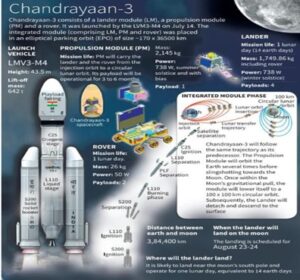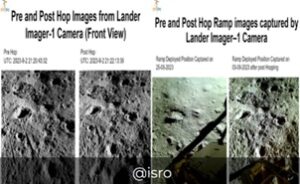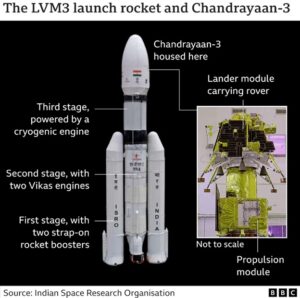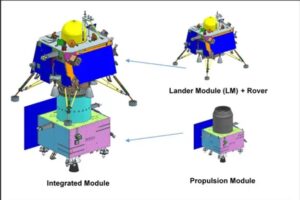Chandrayan 3 exceeded its mission objectives.
Relevance
- GS Paper-3: Science and Technology- developments
- Achievements of Indians in science & technology; indigenization of technology and development of new technology.
- Awareness in the fields of Space.
- Tags: #indianeconomy #challenges #growth #currentaffairs #upsc.
Why in the News?
Exceeding its mission objectives, the Chandrayaan-3 mission’s lander Vikram has achieved another significant milestone as it successfully undertook a hop experiment.
Chandrayaan-3’s Successful Vikram Lander Hop Experiment
- The Indian Space Research Organisation (ISRO) achieved a significant milestone with the Chandrayaan-3 mission’s Vikram lander, which successfully conducted a hop experiment.
- On command, the Vikram lander fired its engines, elevating itself by about 40 cm and safely landing at a distance of 30-40 cm away.
- This achievement holds great importance for future lunar missions, including sample return and human missions.
- On November 17, 1967, NASA’s Surveyor 6 carried out a lunar hop, becoming the first spacecraft to do lift-off from a celestial body.
Post-Hop Experiment Updates
- Instruments and Spacecraft: All systems on the spacecraft and its instruments remain in perfect working order post-hop.
- Instrument Deployment: The ramp, ChaSTE, and ILSA instruments were flawlessly folded back and redeployed.
- Preparing for Lunar Night: Payloads on the lander have been shifted into sleep mode in anticipation of the harsh lunar night, with temperatures dropping below -120 degrees Celsius.
- Early Sleep Mode Activation: To conserve instrument functionality, sleep mode was initiated a few days ahead of the official lunar night commencement.
- Battery-Powered Preservation: The remaining battery capacity will maintain minimal instrument warmth throughout the extended 14-day lunar night.
- Potential Reactivation: If the battery holds up, instruments may be reactivated when sunlight returns, enhancing the mission’s overall success.
Exceeding Mission Objectives: Vikram Lander’s Success
- The Vikram lander not only met but exceeded its mission objectives during the Chandrayaan-3 mission.
- It conducted a successful hop experiment, elevating itself as planned and landing safely. This accomplishment signifies a promising start for future lunar exploration missions.
Pragyan’s Lunar Exploration
The rover Pragyan, part of the Chandrayaan-3 mission, successfully traversed over 100 meters on the lunar surface. This achievement expands our knowledge of the moon’s terrain and geology.
Chandrayaan-3’s Scientific Success and Sleep Mode
- The Chandrayaan-3 mission, including the Vikram lander and Pragyan rover, has achieved its scientific objectives and even exceeded expectations.
- As the mission enters its sleep mode on the moon, scientists express satisfaction with the wealth of data collected and anticipate new findings from the lunar surface.
Challenges Overcome: A Remarkable Journey
- The Chandrayaan-3 mission overcame numerous challenges, from preparing for the project to executing the landing and experiments on the moon.
- Each stage presented unique obstacles, making this achievement a testament to ISRO’s expertise and dedication.
Rover’s Mobility and Communication Challenges
The rover Pragyan faced mobility challenges as it explored the moon’s surface. It had to communicate its findings through the lander, which added complexity to the mission. Additionally, the rover had to navigate obstacles during its explorations.
Key Achievements of Chandrayaan-3
- The Pragyan rover’s Laser-Induced Breakdown Spectroscopy (LIBS) instrument successfully identified elements like aluminum, sulfur, calcium, and iron on the moon’s surface.
- The Vikram lander recorded a ‘moonquake’ and detected an ultra-thin layer of plasma in the lunar atmosphere.
- These findings provide insights into the distinct characteristics of the moon’s atmosphere compared to Earth.
Significance of Observations
- The discovery of sulfur is crucial for understanding the moon’s origin and past surface conditions, particularly explosive events.
- Significant sulfur amounts may indicate lunar volcanic activity and the potential presence of subterranean water.
- Sulfur’s presence offers clues about past lunar life support and the feasibility of constructing structures for human habitation.
Exploring Lunar Water
- Chandrayaan-3’s findings, especially regarding sulfur and oxygen on the moon’s surface, play a pivotal role in narrowing down potential water sources.
- The presence of sulfur and oxygen enhances the likelihood of detecting water.
- ISRO is actively seeking information about lunar hydrogen, which could serve as another indicator of the presence of water.
Plasma Detection and Sulphur Confirmation
- During the mission, one of the payloads onboard Vikram detected the presence of plasma near the lunar surface, while two other payloads confirmed the presence of sulphur in the moon’s south polar region. These findings contribute to our understanding of lunar composition.
Continuous Effort: 24×7 Work
- Throughout the mission, ISRO scientists worked tirelessly, operating the rover and collecting crucial data for in-situ scientific experiments. Time constraints on the lunar surface added to the mission’s intensity.
Mission Objectives Accomplished
- ISRO’s Chandrayaan-3 mission successfully achieved its mission objectives, including demonstrating a safe and soft landing on the lunar surface, rover mobility on the moon, and conducting in-situ scientific experiments.
- All payloads performed as expected, marking a successful milestone in lunar exploration.
All Systems Nominal: Successful Experiment Outcomes
- ISRO reported that all systems involved in the hop experiment performed nominally and remained healthy.
- This assurance of system functionality is crucial for mission success and paves the way for further lunar exploration endeavors.
| Chandrayaan-3
Mission Objectives of Chandrayaan-3 · To demonstrate Safe and Soft Landing on Lunar Surface · To demonstrate Rover roving on the moon and · To conduct in-situ scientific experiments. · It consists of an indigenous Lander module (LM), Propulsion module (PM) and a Rover with an objective of developing and demonstrating new technologies required for Inter planetary missions. Features · The payloads on the Vikram lander and rover Pragyan are the same as those used in the Chandrayaan-2 mission. · These scientific payloads on the lander are geared towards studying various aspects of the lunar environment. The key goals of these payloads include · Investigating lunar quakes to understand seismic activity on the Moon. · Analyzing the thermal properties of the lunar surface to gain insights into its temperature variations. · Monitoring changes in plasma around the lunar surface, helping to better comprehend the Moon’s interaction with the space environment. · Precisely measuring the distance between the Earth and the Moon, contributing to accurate astronomical calculations and space exploration endeavors. |
Sources: The Hindu, The Indian Express, ISRO.
Mains Question
Analyze Examine the key achievements of Chandrayaan-3, focusing on the findings related to elements on the moon’s surface and the lunar atmosphere. Discuss the significance of these observations Explain is hop experiment. 250words.







